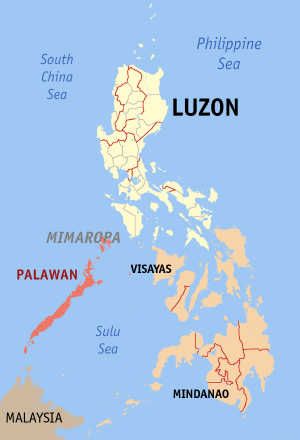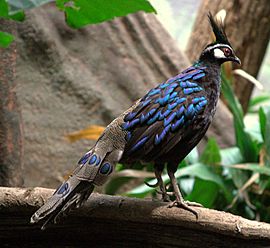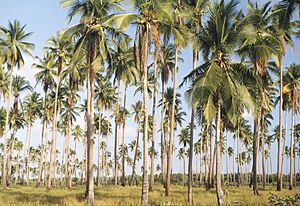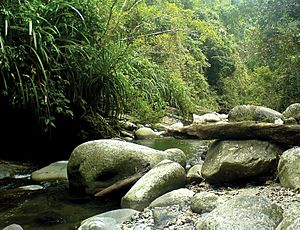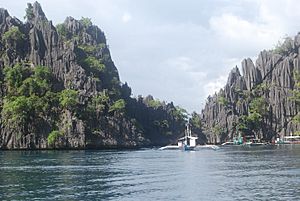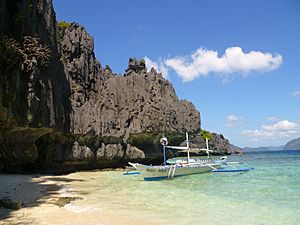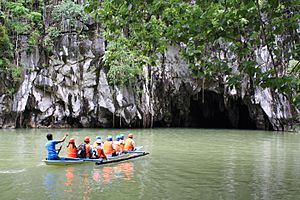Palawan facts for kids
Palawan is a beautiful province in the Philippines. It's made up of many islands and is the largest province in the country by land area. Its capital city is Puerto Princesa, which is a big city that runs itself, separate from the rest of the province.
The islands of Palawan stretch out between Mindoro to the northeast and Borneo to the southwest. It sits between two important seas: the South China Sea and the Sulu Sea. The province gets its name from its biggest island, Palawan Island, which is about 450 kilometers (280 miles) long and 50 kilometers (31 miles) wide.
In 2019, there was a plan to divide Palawan into three smaller provinces. This idea would need people living there to vote on it.
Contents
Geography of Palawan
Palawan province includes the long, narrow main Palawan Island and about 1,780 smaller islands and islets around it. To the northeast, you'll find the Calamianes Group of Islands, which includes Busuanga, Coron, Culion, and Linapacan. Balabac Island is located at the southern tip, close to Borneo. Palawan also includes the Cuyo Islands in the Sulu Sea. The Spratly Islands, located further west, are also considered part of Palawan by the Philippines.
Palawan's coastline is very interesting, with rocky coves and white sandy beaches. The province also has huge areas of untouched forests covering its mountain ranges. These mountains are usually about 1,100 meters (3,500 feet) high, with the tallest peak, Mount Mantalingahan, reaching 2,086 meters (6,843 feet). These large mountain areas are a source of valuable wood. The land is a mix of flat coastal areas, rocky hills, river valleys, and thick forests with rivers that help water the land.
The total land area of Palawan province is about 14,650 square kilometers (5,656 sq mi). If you include Puerto Princesa City, the total area becomes about 17,031 square kilometers (6,576 sq mi).
Palawan's Climate
Palawan has two main types of weather. In the northern and southern parts, and along the entire western coast, there are two clear seasons: six months of dry weather and six months of wet weather. On the eastern coast, there's a short dry season (one to three months) and no clear rainy period for the rest of the year.
The southern part of Palawan usually avoids big storms, but northern Palawan gets heavy rains in July and August. The summer months (March to early June) are the best time to visit Palawan because the seas are calm for boat trips. The average high temperature is about 31°C (88°F) all year round.
Towns and Cities in Palawan
The province of Palawan includes many local governments.
- Mainland towns
- Aborlan
- Bataraza
- Brooke's Point
- Dumaran
- El Nido
- Narra
- Quezon
- Rizal
- Roxas
- San Vicente
- Sofronio Española
- Taytay
- Island towns
- Agutaya
- Araceli
- Balabac
- Busuanga
- Cagayancillo
- Coron
- Culion
- Cuyo
- Kalayaan (Spratly Islands)
- Linapacan
- Magsaysay
Palawan's Economy
Palawan's economy is mostly based on farming. The three main crops grown are rice, corn, and coconuts. The province also has valuable minerals like nickel, copper, manganese, and chromite. Logging (cutting down trees for wood) is another big industry.
Palawan has some of the best fishing areas in the country. About 45% of the fish supplied to Manila comes from here. Palawan is also the only province in the Philippines that produces oil, with large natural gas reserves. In addition to all this, tourism is a very successful part of the economy.
In the past, finding pearls was a big part of Palawan's economy, until plastics became common. The world's largest pearl, the Pearl of Lao Tzu (240 mm or 9.4 inches across), was found off Palawan in 1934.
The economy and farming businesses in Palawan are growing quickly. Besides the main crops, the province also produces sugar, lumber, and raises livestock.
Amazing Plants and Animals of Palawan
Unlike most of the Philippines, Palawan is part of a special area called Sundaland. This means its plants and animals are similar to those found in Borneo.
Many unique animals live only in Palawan. These include the Palawan peacock-pheasant, the Philippine mouse-deer, the Philippine pangolin, the Palawan bearded pig, and the Palawan birdwing butterfly. In the forests and grasslands, you can hear the songs of over 200 kinds of birds. More than 600 species of butterflies fly around Palawan's mountains and fields, attracted to the 1,500 different types of plants found here.
Endangered sea turtles lay their eggs on the white sand beaches. The number of Dugongs (sea cows) has dropped a lot, but Palawan still has more of them than any other part of the country. Groups like Community Centred Conservation (C3) are working to protect marine life in Palawan and the Philippines.
In 2007, a new type of "shrew-eating pitcher plant" called Nepenthes attenboroughii was found on Mount Victoria. Many other pitcher plants have been discovered in this wild mountain area, including one recently named Nepenthes leonardoi.
About 56% of Palawan's land is covered by forests. Mangrove forests, which grow in salty coastal areas, make up about 3.35% of the total land. Grasslands have become smaller, which is a good sign because it means the soil is getting healthier. Brushlands (areas with shrubs and small trees) have increased to 25% of the land.
Under the sea, Palawan has nearly 11,000 square kilometers (4,200 sq mi) of coral reefs. This is more than 35% of all the coral reefs in the Philippines!
Palawan has been called one of the most beautiful islands in the world by Condé Nast Traveler Readers. National Geographic Traveler magazine also named it the best island destination in East and Southeast Asia in 2007. They praised its "incredibly beautiful natural seascapes and landscapes" and its rich variety of life on land and in the sea. Palawan has been a Biosphere Reserve since the early 1990s, showing how much local people care about protecting nature.
The province was also rated "doing well" in a survey by the National Geographic Center for Sustainable Destinations. Conde Nast Traveler magazine voted its beaches, coves, and islets as the best tourist destination with beaches in Asia. Famous underwater explorer Jacques Cousteau said Palawan has one of the most beautiful seascapes in the world.
In 2012, a new species of purple crab was discovered here, along with four other new crab species.
Fun Places to Visit in Palawan
Calauit Game Preserve and Wildlife Sanctuary
This special place is a game reserve and wildlife sanctuary. It's home to exotic African animals and endangered animals that are native to Palawan. The reserve was created in 1976 to help save African wildlife. Later, in 1993, the local government of Palawan took over its management. It's located on Calauit Island in Busuanga.
Coron Reefs: Diving Adventures
Seven lakes surrounded by tall limestone cliffs attract many nature lovers to Coron Reefs in Northern Palawan, near the town of Coron. Busuanga Island, where Coron town is, is the starting point for many diving trips. The main dive sites are 12 Japanese shipwrecks from World War II that were sunk in 1944. They are found at depths from the surface down to 40 meters (130 feet). This variety offers exciting wreck exploration for everyone, from beginners and snorkelers to experienced divers.
The amazing underwater views from these sunken Japanese warships off Coron Island are listed by Forbes Traveler Magazine as one of the top 10 best scuba sites in the world.
El Nido Marine Reserve Park
In 2008, the international magazine Travel + Leisure featured El Nido's resorts, El Nido Lagen Island and El Nido Miniloc Island. They were praised as "conservation-minded places on a mission to protect the local environment." The magazine highlighted El Nido Resort's efforts to protect Palawan's giant clam gardens and bring back endangered Philippine cockatoos. Their guest cottages are built on stilts over the clear ocean, and the resorts are very active in protecting both the reefs and the islands.
Malampaya Sound Land and Seascape Protected Area
Located in the Municipality of Taytay, this important area is a watershed (where water drains into a river or lake) and a fishing ground. It is also home to Bottle-nosed and Irrawaddy dolphins.
UNESCO World Heritage Sites in Palawan
- Puerto-Princesa Subterranean River National Park (added in 1999)
This park has a huge limestone landscape with an underground river. One special thing about the river is that it flows directly into the sea, and the lower part of it is affected by the ocean tides. This area is also very important for protecting many different kinds of plants and animals. The site includes a complete "mountain-to-sea" ecosystem and has some of the most important forests in Asia.
- Tubbataha Reef Marine Park (added in 1993)
The Tubbataha Reef Marine Park covers 332 square kilometers (128 sq mi), including the North and South Reefs. It's a unique example of an atoll reef (a ring-shaped coral reef) with a huge number of marine species. The North Islet is a nesting place for birds and sea turtles. This site is a great example of a healthy coral reef with a spectacular 100-meter (330 ft) vertical wall, large lagoons, and two coral islands.
Ursula Island
This island is a game refuge and bird sanctuary, located near the Municipality of Bataraza in southern Palawan. The small island is a place where shorebirds and seabirds migrate to and spend the winter.
Rasa Island Wildlife Sanctuary
This protected area, which is about 1,983 hectares (4,900 acres) large, is located in the municipality of Narra. It is a nesting ground for the unique Philippine cockatoo or katala. It also protects other rare bird species and marine turtles.
Images for kids
-
Reticulated giraffes inside the Calauit Safari Park
See also
 In Spanish: Provincia de Palawan para niños
In Spanish: Provincia de Palawan para niños


